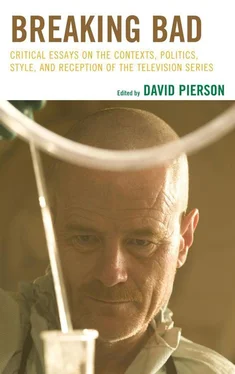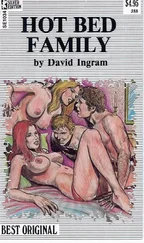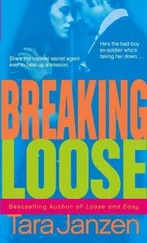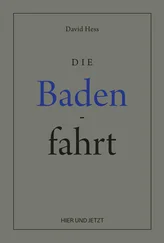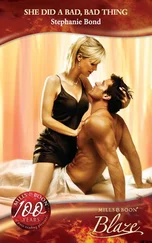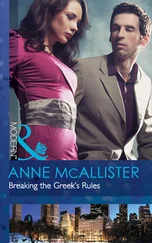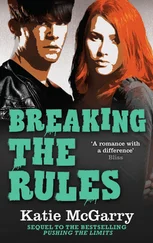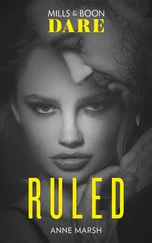Having examined the interest of the image in an outdoor sequence and the shot breakdown of an indoor sequence, and remarked that a second-degree style is abundantly apparent in each, let’s now look at a sequence in which the editing manipulates time. The sequence takes place in the clandestine lab where Walter and Jesse produce their crystal meth. It unfolds without a word being spoken and shows the precise gestures they make and their concentration as they work. This kind of sequence is not new in recent American television fiction. It can be found in particular in the CSI series ( CSI , CSI Miami , CSI New York ), in which forensic medical experts silently and professionally ply their trade in police laboratories. Extra-diegetic music takes the place of dialogue, provides continuity and gives the whole scene the appearance of a mini video clip whose images follow after one another in arbitrary order, making it possible to short-circuit the rules and offer up repeated jump cuts, accelerating the passage of time. Nevertheless, the sequence in Breaking Bad stands apart for its interiorization. It opens on Jesse’s focused eye in close-up as he looks at a container seen in a matched cut-away. The mise en scène makes his gaze forceful, as it did above, and offers up a matched cut. The fact that the scene is silent, in combination with the attention paid to the character’s gaze, leads us to realize that the director has created, to paraphrase Jeremy Butler (2012), a “visual driven world.” There follows a series of short shots of Walter reiterating this aesthetic strategy and taking it a step further. Walt, with his glasses in his hand, looks at a container to the right that then lights up; next, concentrated through his mask, he looks left at another container. This segment calls to mind the beginning of the episode, when Walt changed his glasses, and highlights once again the structuring role of the gaze in the mise en scène while establishing a visual continuity that differentiates White from his context, making him a subject, in the sense of the programming of the gaze, as discussed by Nick Browne (1975) and Daniel Dayan (1983) with respect to the film Stagecoach (1939). In essence, Jesse’s gaze is directed, while Walter’s is orchestrated. It is present before and after the object and thus becomes the subject of the discourse. It is the center of our attention. Afterwards, the series of shots is edited in such a way as to create successive jump cuts and ellipses thereby providing both an outer summary of the two chemists’ work and an inner plunge into the psyche of a character (Walt) who is as tortured as Dexter (Showtime, 2006-present). Like Dexter, Walt uses his scientific knowledge to further his deviant interests. Walt’s successive gestures are those of both a professional and a criminal. This may be true of the gestures of Jesse, but for the viewer, whose reading of the scene has been “programmed” by the “play of images,” it is especially true of those of Walt (Dayan 1983). The overexposed shot which follows synthesizes Walt’s inner conflict. The mise en scène takes us inside Walt’s mind through what we might call, not a flashback or a flash forward, but a flash-in, so that we grasp temporality by means of the visual style in a form with a coefficient of subjectivity, creating an inner time, that of thought. Walt’s synapses create short-circuits; indeed, they fry. Finally, a shot showing Walt’s eyes holds our attention, confirming the importance of the gaze and reasserting the primacy of the visuality. Although his eyes are clearly visible behind his mask, his lips are overtly hidden from view. The image is a synecdoche of this first part of our chapter: while zero-degree style is that of the voice of the other, second-degree style is that of one’s own gaze.
ABQ
Three sequences in the episode “ABQ” (5/31/09) also forcefully demonstrate the work of enunciation and contribute to identifying the series with second-degree style. The first sequence comes before the credits and consists of a series of visually very expressive exterior shots almost entirely in black and white; the second sequence is sandwiched between the other two and, through the editing, creates a series of connections which undeniably form a discourse; and the third uses the mise en scène of a television news crew, a critique of television and its relation to reality—a sequence not without meta-discursive resonance.
The first sequence of “ABQ” appears before the credits and is a recurring element in season two; beginning with the first episode (“Seven Thirty-Seven”), the same sequence—varying in length and its elements in different order—is used as an “enigmatic” prologue to the story that begins after it. [7] As the Wikipedia site notes, the titles of four episodes in which the black-and-white enigmatic sequence appears, when put together in order, form a sentence, which gives the clue, “Seven Thirty-Seven,” “Down,” “Over,” and “ABQ.”
It is made up of twenty-five shots, almost entirely in black and white (we will return to this subject below), made up for the most part of inserts but none of a human face, and accompanied by ambient noise which contributes to the mysterious quality of this highly stylized opening sequence. It begins with a few shots that set the scene (a leaking garden hose, a Chinese lantern, a low stone wall across which a snail is crawling, a swimming pool in the backyard of a private residence) and create a persistent impression that time is “suspended.” The sequence continues with a shot of the water’s surface in the swimming pool. In this shot, at first empty, we soon see a small sphere strongly resembling an eye which quickly crosses the screen from right to left before running up against the pool’s skimmer and disappearing. We hear the sound of a siren, at first far off and then closer. The camera then goes underwater where a fuchsia-colored teddy bear (the only colored element of the sequence) suddenly appears drifting toward the surface. Following a series of dissolves, there is a change in the point of view of the camera—still underwater—and, half-blinded by the sun, we see a silhouette leaning over the pool. The next shot returns to the shadow and then the content of a dip net, in which the teddy bear is seen. A man in a white suit then places the teddy bear in a plastic bin. The camera’s point of view changes again and we see, in slow motion and through the cracked window of an automobile, two men carrying the bin to a service vehicle. A crane shot takes the camera over top of the banged-up car; on the other side, we discover two dead bodies in plastic body bags. The rest of the sequence is made up of several close-up shots of a disparate collection of objects scattered about the garden (a burnt shoe, a dog-eared book, a necktie hanging from the branch of a tree and a small flag stating evidence, please do not remove) and then of a series of shots showing us men in one-piece suits busily cleaning the scene. The sequence concludes with a high-angle crane shot which provides an establishing shot of the entire neighborhood in which the scene is taking place. In the distance, as the image changes from black and white to color, we see two columns of black smoke rising to the sky.
This sequence is significant for at least two reasons. First, aesthetically, it stands out from the rest of the series by its very peculiar use of black and white, in which one object in color creates a striking contrast; what we might call the excessive mobility of the camera creates an exaggerated aesthetic of the content and the image. The world we are shown is thus in no way natural; on the contrary, these elements work together to disconnect the image from the narrative, in a sense, the images take on value on its own right. Second, on the level of enunciation, the camera positions and visual perspectives contribute to the shots’ high degree of subjectivity strongly rooted in a gaze and yet detached from any human body, unless the body and the eye of the teddy bear are proposing we see them as the sequence’s organizing principle. In this sense, it is as if the viewer were looking at the world through the anthropomorphized eye of a child’s toy fallen from the sky (in fact at the end of the episode we learn that the teddy bear landed in the pool when an airplane crashed), an ambiguous symbol of shattered innocence and the Almighty. The eye floating on the water’s surface at the beginning of the sequence, separated from the body of the teddy bear, and the broken-up, overcharged vision it produces thus take on the task of reminding us reflexively of the constructed and subjective nature of the world we are being shown.
Читать дальше
